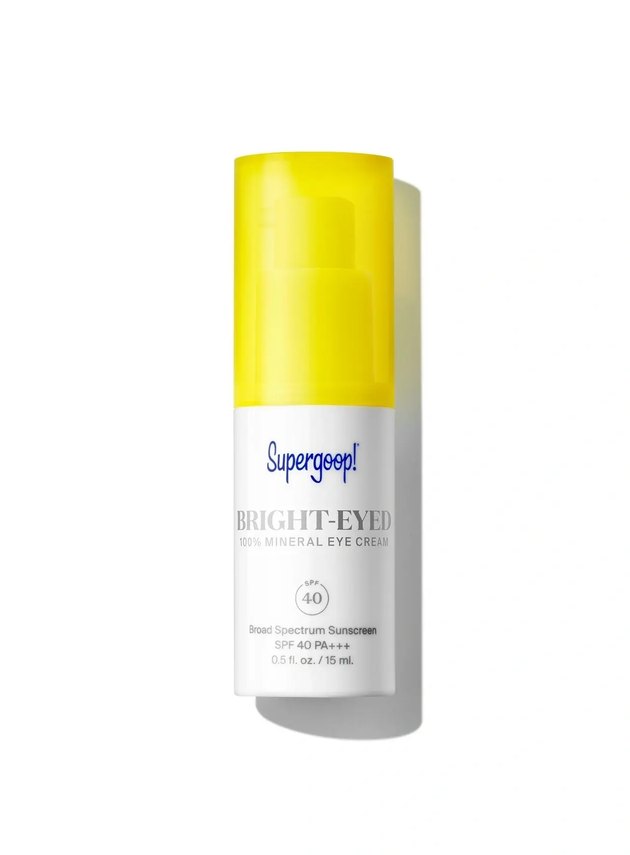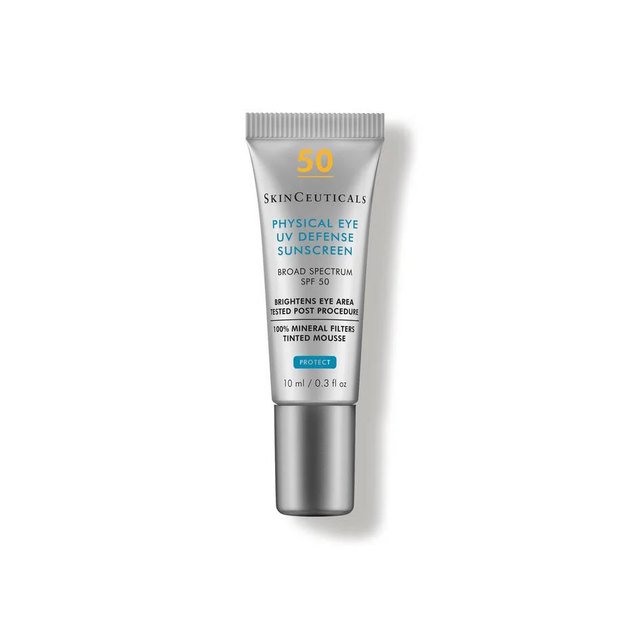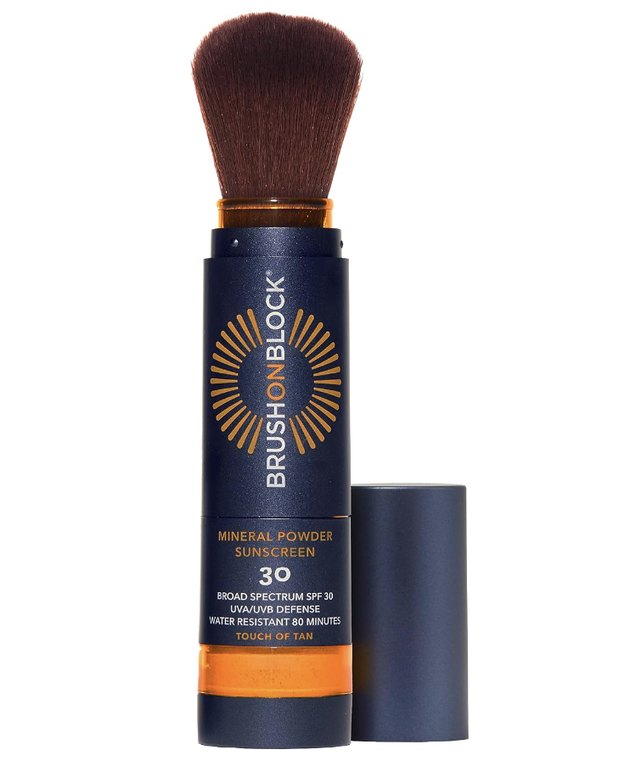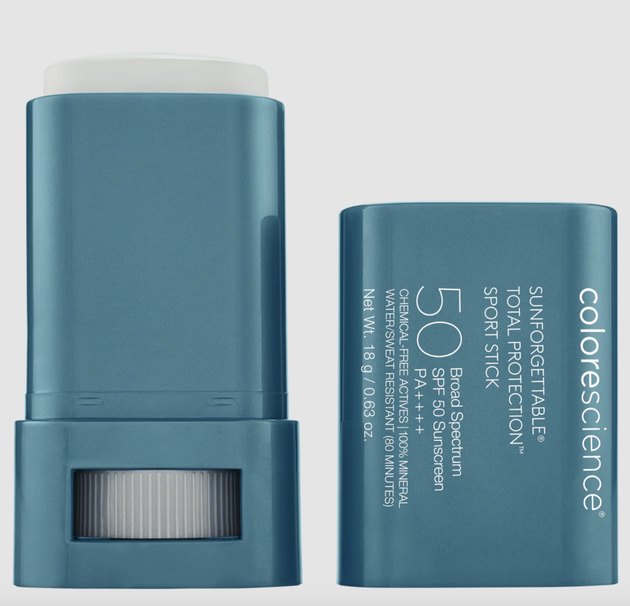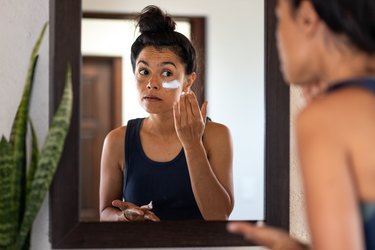
One of the most important things you can do each day to prevent skin cancer (and premature skin aging) is wearing sunscreen every day.
Even if you're great about applying sunscreen, you might still be making sunscreen mistakes — like missing an essential spot when applying SPF on your face: your eye area.
Video of the Day
Video of the Day
In fact, it's common to neglect your eyelids and under-eyes. Many people forget or don't want to apply sunscreen to this area because eye skin is sensitive (and more easily irritated), according to the Skin Cancer Foundation.
But the delicate nature of this skin is exactly what makes it more vulnerable.
"The skin [around your eyes and] on the eyelids is thin, sensitive and can be particularly susceptible to UV damage" and skin cancer, says Ashley Brissette, MD, an ophthalmologist and founder of Daily Practice.
Here, learn how common eyelid skin cancer is, and how to prevent UV damage to this sensitive part of your face.
Tip
“If you have a history of sun exposure and/or a family history of skin cancer and notice any unusual changes around your eyes, consult a dermatologist or ophthalmologist for evaluation,” says Michelle Henry, MD, FAAD, a board-certified dermatologist in New York City.
Causes of Eyelid Skin Cancer
Skin cancer on the eyelids is primarily caused by excessive UV radiation from the sun or other sources, Dr. Brissette says. The same thing is true for the skin all over your body.
But because your eyelid skin is thin (and gets thinner as you age) and sensitive, it's even more susceptible to damage, Dr. Henry says.
How Common Is Eyelid Skin Cancer?
"Skin cancer on the eyelid or around the eye is relatively common," Dr. Henry says.
While "it's less prevalent than skin cancer elsewhere on the body," there are certain risk factors that increase your odds of developing the disease here, Dr. Brissette says.
Risk factors for eyelid cancer include the following, per Stanford Medicine:
- Excessive UV exposure (from sunlight or tanning beds, which both produce UV radiation)
- Fair skin or light-colored eyes (people with less melanin have reduced protection against UV radiation)
- Age (most common skin cancers occur after age 50)
- History of sunburns or fragile skin
- Your medical history (certain health conditions like xeroderma pigmentosum, basal cell nevus syndrome or albinism and people with weakened immune systems have a greater risk)
- Previous skin cancer
Where you live (i.e., strong UV areas), your job (if it requires significant time outdoors) and smoking can also raise your risk, Dr. Brissette says.
Your genetics and exposure to other forms of radiation can play a role, too, Dr. Henry adds.
Types of Eyelid Skin Cancer
There are several types of skin cancer — most related to too much UV radiation — that can affect your eyes.
About 90 percent of skin cancers around the eyes are basal cell carcinomas (or BCCs), according to Stanford Medicine. Left untreated, BCCs can become sizable growths, but the cancer rarely spreads to the lymph nodes or other places on the body, per the Skin Cancer Foundation.
Another type of carcinoma that affects the eye area is squamous cell skin cancer (or SCC), which accounts for roughly 5 percent of cases, according to Stanford Medicine. SCCs have a higher potential for spreading throughout the body, Dr. Brissette says.
Other less common kinds of eyelid skin cancer include the following:
- Melanomas: "These are the most serious form of skin cancer, which you may have a genetic predisposition to, and can arise as a new growth or from existing freckles," Dr. Brissette says. While rare, melanoma can also occur within the eyeball itself, she adds.
- Sebaceous carcinoma: Another type of eyelid cancer that originates in the meibomian (oil) glands, Dr. Brissette says.
- Merkel cell carcinomas: These typically appear on your face, head or neck and tend to grow and spread quickly, according to the Mayo Clinic.
"Other growths are also associated with excessive UV exposure," Dr. Brissette says. For example, pterygium (also called surfer's eye) is a triangular-shaped fleshy tissue on your eye's conjunctiva — the clear layer that covers the white part of the eye — that can expand to your cornea, according to the American Academy of Ophthalmology (AAO).
"Although they are not pre-cancerous, [pterygium] can be unsightly, uncomfortable and may require surgical removal," Dr. Brissette says.
Symptoms of Eyelid Skin Cancer
Eyelid skin cancer can create a variety of symptoms depending on the person. That said, some of the most common signs include the following, per Stanford Medicine:
- A spreading growth on the eyelid that can be red, pink brown or black
- Broken skin on the eyelid that does not heal
- Change in appearance of the eyelid skin (for instance, a change in color or texture)
- Chronic infection of the eyelid
- Loss of eyelashes
- Swelling or thickening of the eyelid
Symptoms can also include bleeding and itchy eyes, Dr. Henry says. Additionally, "changes in vision, such as blurriness, can be a symptom if the cancer affects the eye itself," she adds.
Often, the type of symptoms you have correlates to the kind of skin cancer you have. Some examples include the following, per Dr. Brissette:
- Basal cell carcinoma looks like a raised, shiny bump that may be pearly or translucent in appearance. It can bleed easily, ulcerate or crust over.
- Squamous cell skin cancer look like a firm nodule or a flat, scaly lesion with a crust.
- Melanomas are dark lesions that may have irregular borders, look asymmetrical in shape and have varying colors — similar to melanomas on other parts of the body.
Tip
If you notice any of these symptoms, see your doctor for a comprehensive exam, especially because eyelid cancer can resemble other noncancerous eye conditions like blepharitis (inflammation of the eyelids), according to Stanford Medicine.
How to Prevent Eyelid Skin Cancer
While skin cancer in the eye area happens, it's not inevitable. With a few smart strategies, you can reduce your exposure to UV radiation and therefore, reduce your risk of skin cancer. Some tips include:
1. Slather on Sunscreen
First and foremost, start using sunscreen around your eyes.
"Apply a broad-spectrum sunscreen to your eyelids and the surrounding areas, even on cloudy days," Dr. Brissette says.
When buying sunscreen, look for, "gentle, hypoallergenic formulas designed for sensitive skin or those specifically labeled as safe for use around the eyes," Dr. Henry says. And make sure they have an SPF of at least 30, she adds.
Mineral sunscreen — which is known to be gentler and less irritating than chemical sunscreen — is also a great choice.
Eye-Specific Sunscreen Lotions
Some brands have eye-specific sunscreens, like Supergoop!'s Bright-Eyed 100% Mineral Eye Cream SPF 40 or SkinCeuticals Physical Eye UV Defense SPF 50.
Powder Sunscreen
"Powder brush-on mineral sunscreen is the best and easiest option to apply to the eyelids," Dr. Brissette says.
Some popular mineral brush-on sunscreens to try include the following:
Sunscreen Sticks
If a powder isn't for you, you can also use a sunscreen stick, like the Sunforgettable Total Protection Sport Stick from Colorscience or the allergy-tested liquid sunscreen from Clinique, Dr. Brissette says.
Whichever type of sunscreen product you prefer, always reapply every two hours, she adds.
2. Wear Sport Sunglasses
A good pair of sunglasses can also safeguard the sensitive skin around your eyes from too much sun, Dr. Henry says.
But keep in mind that not all shades are created equal.
"Choose sunglasses that provide 100 percent UV protection to shield your eyes and the delicate skin around them from harmful rays," Dr. Brissette says.
These types are often sports sunglasses for cycling or running.
3. Wear Hats Often
Wearing a wide-brimmed hat when at the beach or pool can further protect your eyes from UV radiation, Dr. Henry says. And the bigger the brim, the better. Larger hats offer extra coverage and protection for your eyes, she says.
4. Limit Your Time in the Sun
Though it's not always possible to avoid the sun (especially if you work outdoors), a good rule is to reduce your overall sun exposure. If you stay out of the sun, you also stay away from harmful UV radiation altogether.
When you must be outside, try "staying in the shade, especially during peak sun hours," Dr. Henry says.
Midday — between 10 a.m. and 4 p.m. — is when the sun is the strongest (even in the winter), according to the Environmental Protection Agency (EPA).
And while staying in the shade protects you somewhat, trees, umbrellas and canopies don't always provide full protection, per the EPA. This is why you should always wear sunscreen, no matter if you're in the shade or full sun.
5. Take Notice of Any Changes Near Your Eyes
Take note of the skin around the eyes often. While there are highly effective treatment options for eyelid skin cancer (more on this later), "early detection and prevention are key," Dr. Henry says. "Regular self-exams and professional evaluations can significantly improve outcomes," she adds.
Checking your eyelids is especially important for people with an increased risk of skin cancer. Still, no matter your level of risk, consult a doctor immediately if you notice any unusual changes or growths in the eye area, Dr. Henry says.
Diagnosis and Treatment of Eyelid Skin Cancer
Diagnosing eyelid skin cancer will, "typically involve a dermatologist or ophthalmologist examining the affected area and possibly performing a biopsy," Dr. Henry says.
"A biopsy is the gold standard of diagnosis," Dr. Brissette agrees. "A sample of tissue can be sent to the lab to determine if the cells are irregular and cancerous."
If malignant cells are present in the biopsy, you have several treatment options, Dr. Henry says. These include the following:
- Surgical excision
- Mohs surgery (microscopically guided removal of cancerous tissue)
- Cryotherapy (freezing)
- Laser therapy
- Radiation therapy
Dr. Henry says treatment choice will depend on the type, size and location of the cancer.
The Bottom Line
It's important to remember to apply sunscreen to your eyelids and eye region when you're applying sunscreen to your body. This area is sensitive and prone to UV damage if left unprotected. If you have sensitive skin, you can find special sunscreen to apply to this area.
And remember, most skin cancers (like basal cell carcinomas and squamous cell skin cancers) are curable and have excellent outcomes if cancerous growths are detected when still small, per Stanford Medicine. So be sure to see your doctor if you notice any signs of eyelid skin cancer.
- Stanford Medicine: “Eyelid Cancer”
- Skin Cancer Foundation: “Focus on Eyelid Skin Cancers: Early Detection and Treatment”
- Mayo Clinic: “Merkel cell carcinoma”
- American Academy of Ophthalmology: “What Is a Pinguecula and a Pterygium (Surfer's Eye)?”
- Environmental Protection Agency: “Ultraviolet (UV) Radiation and Sun Exposure”
- Daily Practice: "Ashley Brissette, MD"
- Skin & Aesthetic Surgery of Manhattan: "Michelle Henry, MD, FAAD"
Is this an emergency? If you are experiencing serious medical symptoms, please see the National Library of Medicine’s list of signs you need emergency medical attention or call 911.
